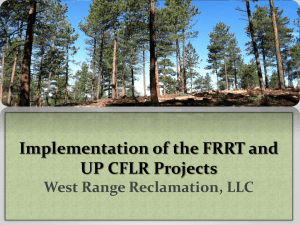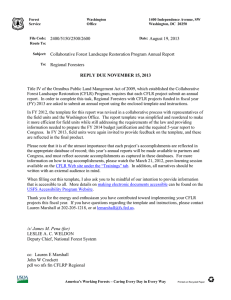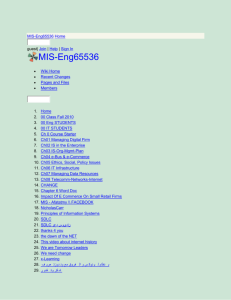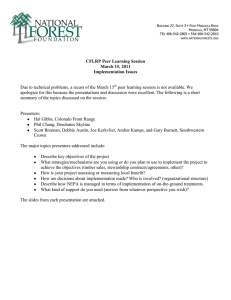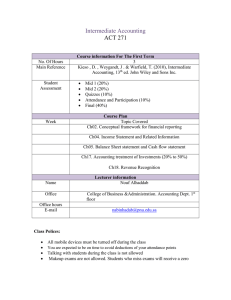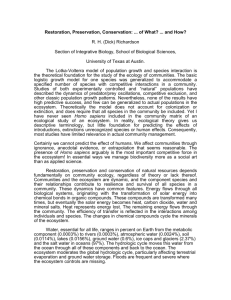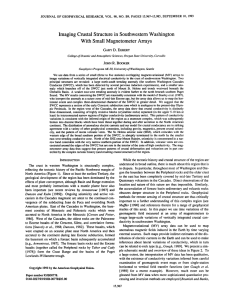CFLRP Work Plan Template 2010
advertisement
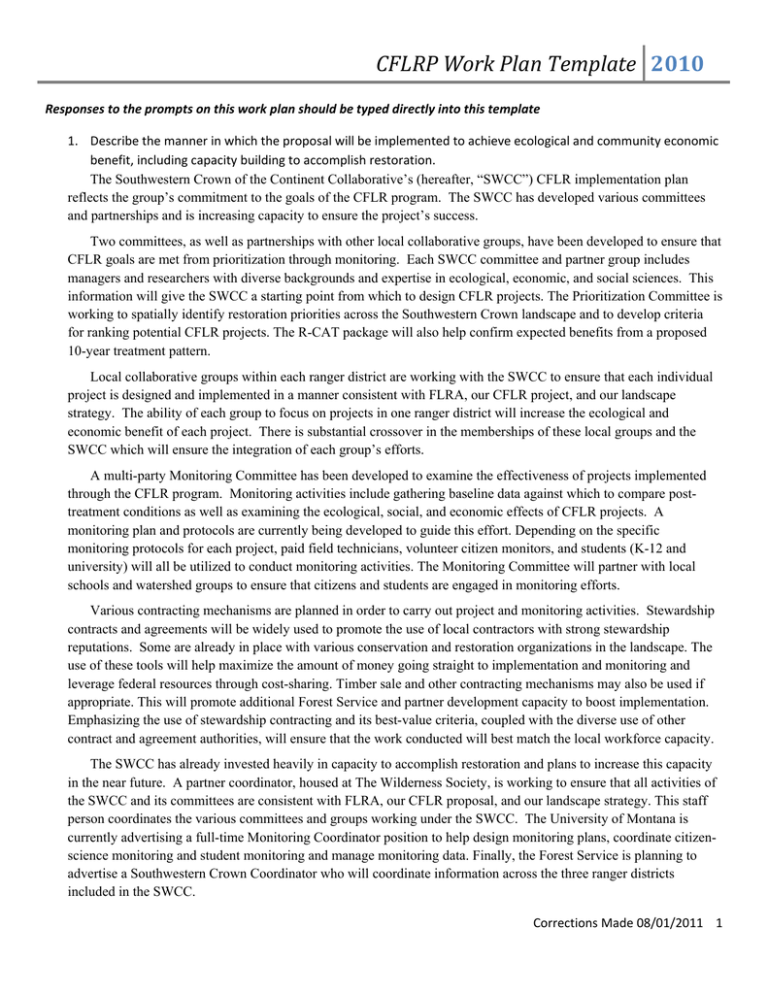
CFLRPWorkPlanTemplate 2010 Responses to the prompts on this work plan should be typed directly into this template 1. Describe the manner in which the proposal will be implemented to achieve ecological and community economic benefit, including capacity building to accomplish restoration. The Southwestern Crown of the Continent Collaborative’s (hereafter, “SWCC”) CFLR implementation plan reflects the group’s commitment to the goals of the CFLR program. The SWCC has developed various committees and partnerships and is increasing capacity to ensure the project’s success. Two committees, as well as partnerships with other local collaborative groups, have been developed to ensure that CFLR goals are met from prioritization through monitoring. Each SWCC committee and partner group includes managers and researchers with diverse backgrounds and expertise in ecological, economic, and social sciences. This information will give the SWCC a starting point from which to design CFLR projects. The Prioritization Committee is working to spatially identify restoration priorities across the Southwestern Crown landscape and to develop criteria for ranking potential CFLR projects. The R-CAT package will also help confirm expected benefits from a proposed 10-year treatment pattern. Local collaborative groups within each ranger district are working with the SWCC to ensure that each individual project is designed and implemented in a manner consistent with FLRA, our CFLR project, and our landscape strategy. The ability of each group to focus on projects in one ranger district will increase the ecological and economic benefit of each project. There is substantial crossover in the memberships of these local groups and the SWCC which will ensure the integration of each group’s efforts. A multi-party Monitoring Committee has been developed to examine the effectiveness of projects implemented through the CFLR program. Monitoring activities include gathering baseline data against which to compare posttreatment conditions as well as examining the ecological, social, and economic effects of CFLR projects. A monitoring plan and protocols are currently being developed to guide this effort. Depending on the specific monitoring protocols for each project, paid field technicians, volunteer citizen monitors, and students (K-12 and university) will all be utilized to conduct monitoring activities. The Monitoring Committee will partner with local schools and watershed groups to ensure that citizens and students are engaged in monitoring efforts. Various contracting mechanisms are planned in order to carry out project and monitoring activities. Stewardship contracts and agreements will be widely used to promote the use of local contractors with strong stewardship reputations. Some are already in place with various conservation and restoration organizations in the landscape. The use of these tools will help maximize the amount of money going straight to implementation and monitoring and leverage federal resources through cost-sharing. Timber sale and other contracting mechanisms may also be used if appropriate. This will promote additional Forest Service and partner development capacity to boost implementation. Emphasizing the use of stewardship contracting and its best-value criteria, coupled with the diverse use of other contract and agreement authorities, will ensure that the work conducted will best match the local workforce capacity. The SWCC has already invested heavily in capacity to accomplish restoration and plans to increase this capacity in the near future. A partner coordinator, housed at The Wilderness Society, is working to ensure that all activities of the SWCC and its committees are consistent with FLRA, our CFLR proposal, and our landscape strategy. This staff person coordinates the various committees and groups working under the SWCC. The University of Montana is currently advertising a full-time Monitoring Coordinator position to help design monitoring plans, coordinate citizenscience monitoring and student monitoring and manage monitoring data. Finally, the Forest Service is planning to advertise a Southwestern Crown Coordinator who will coordinate information across the three ranger districts included in the SWCC. Corrections Made 08/01/2011 1 CFLRPWorkPlanTemplate 2010 2. Anticipated unit treatment cost reduction over ten years: Performance Measure Code Average Historic Unit Cost Cost Reduction per Unit $250/mi/yr $82.50/mi/yr (280 Miles) $12,000 / mile $100/mi/yr (650 Miles) $5,000 - $15,000 / mile $600-1,600/mi/yr $218.45 - 400/ac hand or machine piling ($200-$300/ac) with pile burning ($55/ac) $0 - 297.50/ac $285-675 /ac $0 - 205/ac and less seeding and weed treatment of pile sites TL‐MAINT‐STD RD‐HC‐MAIN RD‐DECOM BIO‐NRG FP‐FUELS‐NON‐ WUI FP‐FUELS‐WUI (Pre-comm. Thin ($200/ac plus either pile burning ($55/ac) and ecosystem /landscape burning ($30/ac) or chipping ($400/ac). Or slashing $250/ac) + Activity slash broadcast underburning ($425/ac). $485-675 /ac (Pre-comm. Thin ($200/ac plus piling ($200-300) + pile burning ($55/ac) and $0-455 /ac plus less seeding and weed treatment of pile sites Assumptions Through one time investments in trail improvement, at roughly $15,000/mi, annual trail maintenance costs expected to decrease by 1/3 on these trails after addressing backlog of trail improvement needs. Through one time investments in high clearance system road best management practices, at roughly $12,000/mi, annual road maintenance costs expected to decrease by $100/mile on these roads. Through one time investments in system road decommissioning at roughly $515,000/mi, annual road maintenance costs expected to be eliminated for these miles. Existing maintenance costs for candidate roads is $6 - 8,000/mile, done every 5-10 years. Cost reduction comes from increased revenue through the sale of small diameter materials (33.7 green tons/ac) at more than minimum rates, relieving the need for small diameter adjustment on saw log stumpage, as well as avoided hand piling and pile burning costs. Cost reduction comes from increased revenue through the sale of small diameter materials ($0-5 *30 green tons/ac) at more than minimum rates, relieving the need for small diameter adjustment on saw log stumpage, as well as avoided pile burning costs ($55/ac). Cost reduction comes from increased revenue through the sale of small diameter materials (40 green tons/ac) at more than minimum rates, relieving the need for small diameter adjustment on Corrections Made 08/01/2011 2 CFLRPWorkPlanTemplate 2010 Performance Measure Code Average Historic Unit Cost ecosystem /landscape burning ($30/ac) or chipping ($400/ac). Or slashing $250/ac) + Activity slash broadcast under burning ($425/ac). Cost Reduction per Unit Assumptions saw log stumpage, as well as avoided hand piling ($200/ac – more fuel removal, and piling costs with lower tons per acres slash left in the WUI) and pile burning costs ($55/ac). *Although delivered prices range from $30‐60 / bone dry ton, green tons are roughly 40% moisture content and grinding and delivery explain much of this price and will reduce prices paid to FS for raw material in the woods significantly. Therefore, the estimate for product value is estimated $0‐5/green ton, assuming 1‐3 biomass utilization facilities are operational. However, the lack of disposal at small piles throughout treatment units will reduce hand piling, pile burning and potentially seeding and weed treatment for dispersed small burn sites. 3. Anticipated costs for infrastructure needed to implement project**: Type of Infrastructure Temporary Roads Anticipated Cost Construction at an average of $6,000/mi. (ranging from $3,000 – 14,000/mi.) and removal at an average of $4,000/mi. (ranging from $1,500 – 5,000/mi.) for 38* Miles. Total cost is $380,000 Funding Source (federal, private, etc) Federal FS Job Codes, NFTM, NFRD, and others *Estimates from similar projects in this landscape suggest 1 mile of temp road is constructed and decommissioned for every 5 MMBF of saw log volume produced across each project area. The total estimate for the project was 190 MMBF, and therefore 38 miles are likely needed, averaged across ten years this is 3.8 miles per year. **Note: in an earlier version of this work plan two facilities, which if they were constructed could received biomass from SWCC projects, were identified in this table. The SWCC is not dependent on these facilities being constructed. Having these two facilities in this table caused confusion and so were removed from the table in this corrected version of the work plan. Corrections Made 08/01/2011 3 CFLRPWorkPlanTemplate 2010 4. Projected sustainability of the supply of woody biomass and small diameter trees removed in ecological restoration treatments: Fiscal Year 2010 2011 2012 2013 2014 2015 2016 2017 2018 2019 Number of acres to be treated 2,252* 1,575*** 7,300**** 7,300 7,300 7,300 7,300 7,300 7,300 7,300 Projected Green Tons Removed per Acre 33.7 33.7 33.7 33.7 33.7 33.7 33.7 33.7 33.7 33.7 Total Green Tons Available 75,892* 53,078 246,010 246,010 246,010 246,010 246,010 246,010 246,010 246,010 * Actual number of acres treated based on funding received for FY2010, annual report combined saw and non‐saw estimate of green tons. This estimate is for small diameter biomass material only. ** Weighted yield, 27,000 ac. (37%) WUI at 40 green tons/ac., and 46,000 ac. (63%) non WUI at 30 tons/ac. ***We were advised to anticipate 0.7 percent of FY 2010 funding for FY2011 under continuing resolution, but this does not account for possible funding reductions associated with cost pools. **** Estimate for ten year total, 73,000 acres divided by ten years, reflecting average flow over ten years, based on full funding. 5. Projected local economic benefits: Type of projects Commercial Forest Products Other Project Activities TOTALS: Total direct jobs 40 43 83 Total jobs 106 53 167 Total Direct Total Labor Labor Income Income1 $2,362,575 $4,359,867 $2,289,308 $2,862,291 $4,651,883 $7,222,157 The TREAT estimates reflect actual CFLR funds from FY 2010, 70% of FY2010 funds for FY2011, and the full requested fund amounts for 2012‐2019. Similarly, volumes include what was harvested in FY 2010, 70% of this amount for FY 2011 and half of the amount projected to be harvested with all funds each year (1/10 of the 10‐year total in the proposal harvested each year) for FY 2013‐2019 reflecting an approximation of the outputs attributable to CFLR Funds only. There are an estimated 12 annual FTEs of Forest Service employment derived from CFLR fund contributions. 1 Values obtained from Treatment for Restoration Economic Analysis Tool (TREAT) spreadsheet, “Impacts‐Jobs and Income” tab. Spreadsheet available at INSERT WEBSITE HERE Corrections Made 08/01/2011 4 CFLRPWorkPlanTemplate 2010 6. Document the non‐Federal investment in the priority landscape: Source of Investment Big Blackfoot Chapter TU Blackfoot Challenge Blackfoot Challenge Blackfoot Challenge Blackfoot Challenge Blackfoot Challenge Clearwater Resource Council Clearwater Resource Council Ecosystem Management Research Inst MT DNRC/Forestry Division MT DNRC/Trust Lands MT DNRC/Trust Lands MT DNRC/Trust Lands MT DNRC/Trust Lands MT DNRC/Trust Lands MT DNRC/Trust Lands MT DNRC/Trust Lands MT DNRC/Trust Lands MT FWP MT FWP Northwest Connections Northwest Connections Northwest Connections Northwest Connections Private landowners Private landowners Private landowners Rocky Mountain Elk Foundation Swan Ecosystem Center Swan Ecosystem Center Swan Ecosystem Center Swan Ecosystem Center Swan Ecosystem Center Swan Ecosystem Center Swan Ecosystem Center Swan Ecosystem Center The Nature Conservancy Total Non-federal Investments: Amount of Investment $1,250,000 $500,000 $500,000 $52,800 $50,000 $20,000 $200,000 $50,000 $150,000 $100,000 $50,000 $80,000 $5,000,000 $450,000 $500,000 $30,000 $7,000 $3,000 $1,000,000 $500,000 $150,000 $400,000 $150,000 $200,000 $1,500,000 $700,000 $500,000 $100,000 $40,000 $20,000 $500,000 $50,000 $120,000 $55,000 $620,000 $20,000 $28,000,000 $43,617,800 Description of Use Private contributions Fire management Wildlife conservation Stream restoration Weed management BMP road improvements Aquatic monitoring Weed management Monitoring Private landowner assistance Collaboration Road BMP inventory & maintenance Forest products sales cost Misc. PC thinning Tree planting Weed management Good Shepard Timber Sale Aspen restoration Wildlife habitat improvements Fish monitoring Fish monitoring and restoration Wildlife management Whitebark pine restoration Workforce trainings/assessments Fire mgmt cost-share with MT DNRC Fire mgmt cost-share with NRCS/EQIP Fire mgmt cost-share with BLM Stewardship Agreements Wetland restoration, landowner in-kind BMP road improvements Private land forest stewardship Weed management, private land Tree insects management, private land Aquatic monitoring, restoration Wilderness, non-wilderness trail mgmt. Elk Creek Conservation Area mgmt. Land conservation Corrections Made 08/01/2011 5 CFLRPWorkPlanTemplate 2010 7. Plans to decommission any temporary roads established to carry out the proposal: Projected accomplishment year (fiscal) 2010 2011 2012 2013 2014 2015 2016 2017 2018 2019 Number of Miles to be Decommissioned 0* 3.8** 3.8 3.8 3.8 3.8 3.8 3.8 3.8 3.8 * There is roughly a 2 FY lag between construction and decommissioning temp roads built for 2010 will be decommissioned in 2012. ** Estimates from similar projects in this landscape suggest 1 mile of temp road is constructed and decommissioned for every 5 MMBF of saw log volume produced across each project area. The total estimate for the project was 190 MMBF, and therefore 38 miles are likely needed, averaged across ten years this is 3.8 miles per year. Corrections Made 08/01/2011 6
